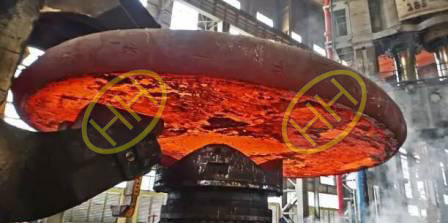What is hot forging process?
When a piece of metal is hot forged it must be heated significantly. The average forging temperature necessary for hot forging of different metals is:
- Up to 1150 degrees Celsius for Steel
- 360 to 520 degrees Celsius for Al-Alloys
- 700 to 800 degrees Celsius for Cu-Alloys
During hot forging, the temperature reaches above the recrystallization point of the metal. This kind of extreme heat is necessary in avoiding strain hardening of the metal during deformation. In order to prevent the oxidation of certain metals, like super alloys, a type of hot forging called isothermal forging is a good choice. In isothermal forging, the metal deformation occurs within a highly controlled atmosphere, similar to that of a vacuum.

Large Size Forged Blind Flanges Under Production
This process usually involves heating the metal (to the above its recrystallization point) after which it is smashed into a die – depending on the requirements, this die can also be heated. Because the metal is hot, it ‘moves around’ easily and allows manufacturers to create more elaborate shapes than with cold forging.
With super alloys (which have low forgeability), processes such as isothermal forging – where deformation takes place within a controlled atmosphere – is used in order to avoid oxidation.
Isothermal forging, also know as hot die forging, is a hot working process which entails the workpiece being maintained at its maximum elevated temperature throughout the entire forming process.
Maintaining this temperature is done by heating the die – this will be at the temperature of, or slightly lower than the elevated temperature of the workpiece. Forces exerted by this die forms the workpiece and, because the die is also at an elevated temperature, cooling of the workpiece between the mold work interface is eliminated. This in turn results in an improvement of the metal’s (workpiece’s) flow characteristics.
Hot Forging Benefits
The hot forging process produces the most various shapes compared to other forging processes, and as the dies are not very expensive to produce, it is very well adapted to small batches and shapely components. Actually, other processes (warm and cold forging) are designed for high volume production such as automotive, and fasteners components, with simplier geometry, for which extremely complex dies can be designed, and amortized on a large number of parts produced with.
- Good ductility
- Possibility to manufacture customized parts
- Excellent surface quality
- High formability ratios
- Decreased yield strength and thus less energy required
- Increased diffusion and thus reduced chemical inhomogeneity
Haihao Group manufacture & supply high quality forged pipe fittings and flanges in different dimensions,standards,materials.If you want to know more about our piping products,please email us:sales@haihaogroup.com

